Related Research Articles
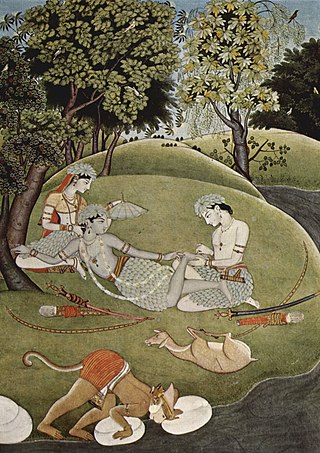
The Rāmāyana is a Sanskrit epic composed over a period of nearly a thousand years, with scholars' estimates for the earliest stage of the text ranging from the 2nd BC to 1st centuries AD, and later stages extending up to the 2nd century AD. Ramayana is one of the two important epics of Hinduism, the other being the Mahābhārata.

Hanuman, also called Anjaneya, is a Hindu god and a divine vanara companion of the god Rama. Hanuman is one of the central characters of the Hindu epic Ramayana. He is an ardent devotee of Rama and one of the Chiranjivis. Hanuman is regarded to be the son of the wind-god Vayu, who in several stories played a direct role in Hanuman's birth, and considered to be an incarnation of Shiva in Shaivism. Hanuman is mentioned in several other texts, such as the epic Mahabharata and the various Puranas.

Lakshmana, also spelled as Laxmana, is the younger brother of Rama and his loyalist in the Hindu epic Ramayana. He bears the epithets of Saumitra and Ramanuja. He is the twin of Shatrughna.

Brahmagiri, is a mountain range in the Western Ghats of south India. It is situated on the border between Kodagu district in Karnataka state in the north and Wayanad district of Kerala state on the south. Brahmagiri Hill, at 1608 m height, is a scenic tourist attraction. The top of Brahmagiri Hill is well forested and has much wildlife.

Ramcharitmanas, is an epic poem in the Awadhi language, based on the Ramayana, and composed by the 16th-century Indian bhakti poet Tulsidas. This work is also called, in popular parlance, Tulsi Ramayana, Tulsikrit Ramayana, Tulsidas Ramayana or simply Manas. The word Ramcharitmanas literally means "Lake of the deeds of Rama". It is considered one of the greatest works of Hindu literature. The work has variously been acclaimed as "the living sum of Indian culture", "the tallest tree in the magic garden of medieval Indian poetry", "the greatest book of all devotional literature" and "the best and most trustworthy guide to the popular living faith of the Indian people".

Sita also called as Janaki and Vaidehi is a Hindu goddess and the female protagonist of the Hindu epic, Ramayana. She is the consort of Rama, the avatar of the god Vishnu, and is regarded as a form of Vishnu's consort, Lakshmi. She is also the chief goddess of Rama-centric Hindu traditions. Sita is known for her dedication, self-sacrifice, courage, and purity. She is one of the seventeen national heroes of Nepal.

Kumbhakarna is a powerful rakshasa and younger brother of Ravana from the Hindu epic Ramayana. Despite his gigantic size and appetite, he is described as a virtuous character and a great warrior in Hindu texts. He is said to have slaughtered 8,000 vanaras over the course of Rama's mission to rescue Sita.

Sundara Kanda is the fifth book in the Hindu epic Ramayana. The original Sundara Kanda is in Sanskrit, and was composed in popular tradition by Valmiki, who was the first to scripturally record the Ramayana. Sundara Kanda is the only chapter of the Ramayana in which the principal protagonist is not Rama, but Hanuman. The work depicts the adventures of Hanuman and his selflessness, strength, and devotion to Rama are emphasised in the text. Hanuman is believed to have been fondly called “Sundara” by his mother Anjana, and Sage Valmiki is stated to have chosen this name over others as the Sundara Kanda is about Hanuman's journey to Lanka.

Sampati is a demigod in Hinduism. He is the elder son of Aruṇa and Shyeni. He is the elder brother of Jatayu. He has the form of either a vulture or an eagle. According to the Brahma Purana, Sampati is said to have a son named Babhru, who is swift and very well-known. Sampati loses his wings when he is a child.

Kishkindha is a kingdom of the vanaras in Hinduism. It is ruled by King Sugriva, the younger brother of Vali, in the Sanskrit epic Ramayana. According to the Hindu epic, this was the kingdom that Sugriva ruled with the assistance of his counsellor, Hanuman.
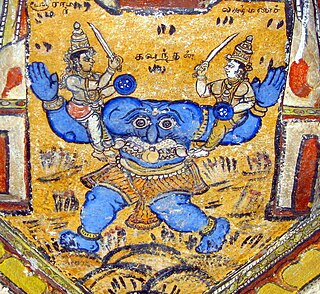
In Hinduism, Kabandha is a Rakshasa (demon) who is killed and freed from a curse by the god Rama – an Avatar of Vishnu – and his brother Lakshmana. Kabandha's legend appears in the Hindu epics Ramayana and Mahabharata, as well as in later Ramayana adaptations.
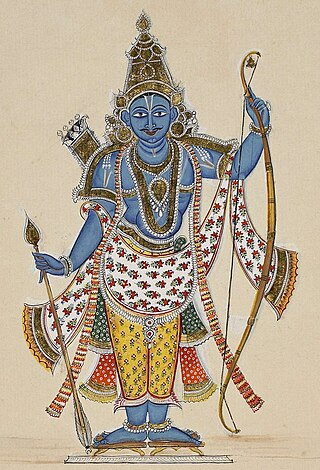
Rama is a major deity in Hinduism. He is the seventh and one of the most popular avatars of Vishnu. In Rama-centric traditions of Hinduism, he is considered the Supreme Being.

Sri Rama Rajyam is a 2011 Indian Telugu-language Hindu mythological film directed by Bapu who co-wrote the film with Mullapudi Venkata Ramana, and produced by Yalamanchali Saibabu. The film stars Nandamuri Balakrishna, Nayanthara, Akkineni Nageswara Rao, Srikanth, and its music was composed by Ilaiyaraaja. The film was Bapu's final directorial venture. Based on the epic Ramayana, it depicts Rama's rule of Ayodhya after he returns home from Lanka, his separation from Sita and her reclusive life in the forest as she raises their children Lava and Kusa. Sri Rama Rajyam is a reboot of the 1963 blockbuster film Lava Kusa.
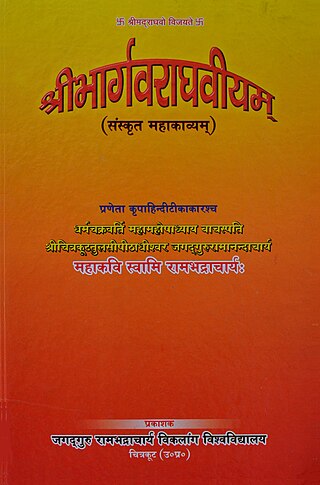
Śrībhārgavarāghavīyam (2002), literally Of Paraśurāma and Rāma, is a Sanskrit epic poem (Mahākāvya) composed by Jagadguru Rambhadracharya (1950–). It consists of 2121 verses in 40 Sanskrit and Prakrit metres and is divided into 21 cantos (Sargas) of 101 verses each. The epic is the narrative of the two Rāma Avatars – Paraśurāma and Rāma, which is found in the Rāmāyaṇa and other Hindu scriptures. Bhārgava refers to Paraśurāma, as he incarnated in the family of the sage Bhṛgu, while Rāghava refers to Rāma as he incarnated in the royal dynasty of king Raghu. For the work, the poet was awarded the Sahitya Akademi Award for Sanskrit in 2005, and several other awards.

Bhṛṅgadūtam (2004), literally The bumblebee messenger, is a Sanskrit minor poem (Khaṇḍakāvya) of the Dūtakāvya (messenger-poem) genre composed by Jagadguru Rambhadracharya (1950–). The poem consists of 501 verses in the Mandākrāntā metre divided in two parts. Set in the context of the Kiṣkindhākāṇḍa of Rāmāyaṇa, the poem describes the message sent via a bumblebee by Rāma, spending the four months of the rainy season on the Pravarṣaṇa mountain in Kiṣkindhā, to Sītā, held captive by Rāvaṇa in Laṅkā.
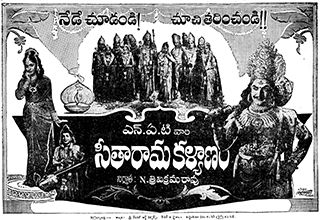
Sita Rama Kalyanam is a 1961 Indian Telugu-language Hindu mythological film directed by N. T. Rama Rao in his directorial debut. It stars N. T. Rama Rao, Haranath, Geetanjali, B. Saroja Devi, Kanta Rao, Sobhan Babu. The film was produced by N. Trivikrama Rao on 'National Art Theatres' banner. The music composed by Gali Penchala Narasimha Rao.
Ramleela – Ajay Devgn Ke Saath, commonly known as Ramleela is a mythological on-stage musical drama, based on the famous Indian epic poem Ramayan. The show premiered on 21 October 2012 on Life OK and completed the story in five episodes on 18 November 2012. The show was narrated by Bollywood actor Ajay Devgn, who provided a prologue at the beginning of each episode or act. The show aired during the period from Dussehra in October till Diwali in November.

In some adaptations of the Hindu epic Ramayana, Maya Sita or Chaya Sita is the illusionary duplicate of the goddess Sita, who is abducted by the demon-king Ravana of Lanka instead of the real Sita.
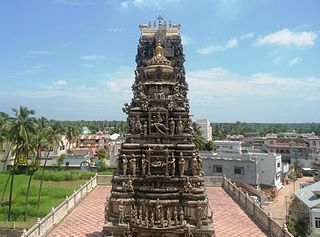
Kodandarama Temple is a Hindu temple located in Gollala Mamidada in Kakinada district of Andhra Pradesh, India. The temple is dedicated to Rama, the seventh incarnation of Vishnu. It was built on the banks of Tulyabhaga (Antharvahini), a tributary of Godavari. The temple is notable for its unique architecture and two huge gopurams which stand at 160–170 feet and 200–210 feet. The temple gopurams are adorned with intricately carved statues depicting scenes from Ramayana, Mahabharata, and Bhagavatam.

The Periya Tirumatal is a Tamil Hindu work of literature penned by Thirumangai Alvar, one of the twelve Alvars of Sri Vaishnavism. The work is a part of the compendium of hymns called the Naalayira Divya Prabandham. The Periya Tirumatal consists of 78 hymns, referred to as pasurams.
References
- ↑ Venkataraman, M. (2022-06-18). Slokas of Sri Ramodantam: Annotated in English. Venkataraman M.